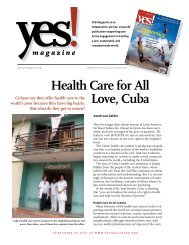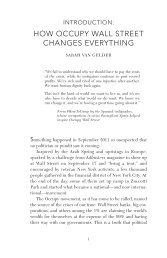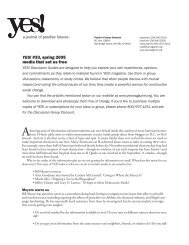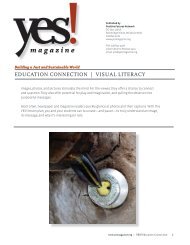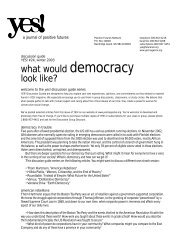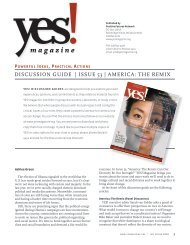Download this lesson plan as a PDF - YES! Magazine
Download this lesson plan as a PDF - YES! Magazine
Download this lesson plan as a PDF - YES! Magazine
You also want an ePaper? Increase the reach of your titles
YUMPU automatically turns print PDFs into web optimized ePapers that Google loves.
yes!<br />
m a g a z i n e<br />
Building a Just and Sustainable World<br />
Published by<br />
Positive Futures Network<br />
P.O. Box 10818<br />
Bainbridge Island, WA 98110-0818<br />
206/842-0216<br />
www.yesmagazine.org<br />
FAX: 206/842-5208<br />
subscriptions: 800/937-4451<br />
email: yes@yesmagazine.org<br />
EDUCATION CONNECTION | VISUAL LEARNING<br />
Images, photos, and pictures stimulate the mind. For the viewer, they offer a chance to connect<br />
and question. They also offer potential for play and imagination, and pulling the observer into<br />
purposeful messages.<br />
Most often, newspaper and magazine readers quickly glance at photos and their captions. With <strong>this</strong><br />
<strong>YES</strong>! <strong>lesson</strong> <strong>plan</strong>, you and your students can luxuriate—and pause—to truly understand an image,<br />
its message, and why it’s interesting (or not).<br />
www.yesmagazine.org :: <strong>YES</strong>! Education Connection 1
yes!<br />
m a g a z i n e<br />
EDUCATION CONNECTION | VISUAL LEARNING<br />
It’s in the Bag<br />
Step One: What do you notice? (before the facts)<br />
Ask your students to make sense of the photograph by trusting<br />
their instincts of observation and inference. In doing so,<br />
the photograph offers possibilities and interpretations beyond<br />
a typical reading where the reader glances at the picture to reinforce<br />
their interpretation of the picture’s title or caption. Do not<br />
introduce any facts, captions, or other written words outside of<br />
the image. You may hear: fluffy costumes, columns and big windows,<br />
group of people.<br />
Step Two: What are you wondering? (thinking about<br />
the facts)<br />
After you’ve heard what your students are noticing, you’ll probably<br />
hear the peppering of questions: Why are the three men<br />
wearing weird costumes? What are the costumes made out of? Is <strong>this</strong><br />
a hotel lobby? This is a good time to reveal the photo’s caption,<br />
accompanying quote, and facts about the actual situation. Watch<br />
how the conversation shifts from what they believe to be true to<br />
discerning the facts about the photo.<br />
Photo caption:<br />
Ban the Bag PDX Pl<strong>as</strong>tic Bag Monsters attend a Portland, OR<br />
City Council meeting to testify about pl<strong>as</strong>tic bag pollution and<br />
call for a pl<strong>as</strong>tic bag ban in the city.<br />
Photo facts:<br />
The Bag Monster is a shocking visual representation of the average<br />
amount of pl<strong>as</strong>tic bags a single shopper uses in a year.<br />
Each bag monster wears 500 pl<strong>as</strong>tic shopping bags. Advocates<br />
for pl<strong>as</strong>tic bag reduction dress <strong>as</strong> bag monsters to demonstrate<br />
the impact of individual shoppers and attend parades, hearings,<br />
and public events to encourage pl<strong>as</strong>tic bag bans on city and state<br />
levels.<br />
According to the Wall Street Journal, the U.S. goes through 100<br />
billion pl<strong>as</strong>tic shopping bags annually, with an estimated cost to<br />
retailers of $4 billion.<br />
Pl<strong>as</strong>tic bags, bottles, and other consumer products from land<br />
comprise 80 percent of the Great Pacific Garbage Patch, and<br />
have been cited <strong>as</strong> the cause of deadly floods in Bangladesh and<br />
Mumbai. This patch represents a convergence zone stretching<br />
thousands of miles across the North Pacific Ocean, between the<br />
United States and Japan. Estimated weight of <strong>this</strong> pl<strong>as</strong>tic m<strong>as</strong>s<br />
is 100 million tons.<br />
2<br />
<strong>YES</strong>! Education Connection :: www.yesmagazine.org<br />
The amount of petroleum used to make a pl<strong>as</strong>tic bag would<br />
drive a car approximately 11 meters.<br />
Pl<strong>as</strong>tic is a material that is created to l<strong>as</strong>t permanently, yet is<br />
often used just once. Only one to three percent of pl<strong>as</strong>tic bags<br />
are recycled worldwide.<br />
Pl<strong>as</strong>tic bags are not biodegradable; they actually photodegrade.<br />
This means pl<strong>as</strong>tic bags break down into small toxic bits, contaminating<br />
soil and waterways, and are ingested by fish—which<br />
people eat. Approximately 2.5 billion people in the world rely on<br />
fish for at le<strong>as</strong>t 20 percent of their animal protein.<br />
Additional resources around the image:<br />
READ :: Cities Take Up the “Ban the Bag” Fight<br />
LEARN :: Ban the Bag PDX<br />
INVESTIGATE :: Bag Monster<br />
EXPLORE: TEDTalk—Charles Moore on the Se<strong>as</strong> of Pl<strong>as</strong>tic<br />
Step Three: What next? (jumping off the facts)<br />
1. Pl<strong>as</strong>tic bags are a convenient part of many people’s daily<br />
lives. What are viable alternatives to pl<strong>as</strong>tic bags? Why do we use<br />
pl<strong>as</strong>tic bags when there are other options?<br />
2. The best answer to the question, “Paper or pl<strong>as</strong>tic?” would be<br />
“Ple<strong>as</strong>e put it in <strong>this</strong> cloth bag I brought with me.” Do you think<br />
<strong>this</strong> is a realistic option for you and your family? For most people?<br />
What would it take to change your and your family’s habits?<br />
3. Pl<strong>as</strong>tic bag banners have had lots of opposition at the state<br />
level and started advocating for citywide bans instead. Why are<br />
activists usually more successful on a city level? What are the<br />
arguments against banning pl<strong>as</strong>tic bags? Do you think these<br />
arguments are valid?<br />
4. Advocates and opponents of a pl<strong>as</strong>tic bag ban use all sorts<br />
of statistics to make their c<strong>as</strong>e to elected officials and to the public.<br />
Opponents claim that pro-ban supporters are deciding with<br />
their emotions, not the facts. Do you agree? When you make a<br />
decision, what carries more weight—statistics and facts, or emotions<br />
and beliefs?



